L. Neil Smith’s THE LIBERTARIAN ENTERPRISE
Number 926, June 11, 2017
can have unlimited tolerance for the intolerant.
—Carl Popper.
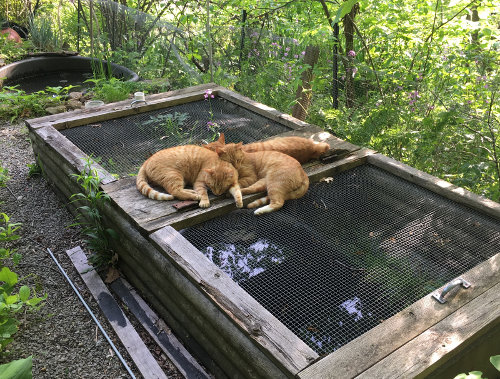
The Norseman's Diaries: Spring Edition from Scratch
by Jeff Fullerton
[email protected]
Attribute to L. Neil Smith’s The Libertarian Enterprise
Saturday morning the third day of June.
After a rather chilly ending—Spring is coming to an end and it is time for a long overdue edition that would have been done sooner were it not for memory problems plaguing my iPhone that required some desperate measures to free up space in order to function. Unfortunately in the process I accidentally deleted the threads that I intended to source my dated entries from —along with a good bit of other stuff I shouldn't have —and so the article had to be done from scratch as opposed to mining ready made text. The upside of it is that I am now able to take more pictures and can probably compose something without that annoying pop up telling me I have to manage storage space and won't let me access email until I delete stuff.
So here goes a recap of the events going back to the end of my vacation in April when I composed my last contribution to this journal.
It had been a rather warm spring on the heels of a somewhat above normal winter that had been featured in the previous editions of the Norseman's Diaries and may go down as one of my more memorable winters as far as the winter flower show was going into spring. There had been many pleasantly warm spells in February and March that were broken up by bouts of cold—but nothing really severe and that trend continued on into April which in the latter weeks got downright hot and summer like before the bottom dropped out in May.
So much for the Hottest Year Evuh!
But late spring is often like that here in Western Pennsylvania. I have seen many a May that is notoriously wet and chilly and even plagued by a few killing frosts that are a threat up to around the 20th of the month—which is the local date when it is deemed safe to put out tender plants and plant summer bulbs. Yet that is not always a given. In a previous article several years ago I noted that I was covering plants around Memorial Day. And my grandmother told me about ice forming on a lake in the early 1900s —in the month of June!
I was lucky this year in that regard. I covered some plants and pulled the Agaves back into the greenhouse a couple times that were almost for naught because it didn't frost locally. I'm guessing there will be those who will consider that yet another sign of doom. But it could very well be a sign of good things to come—as I stand by previous discussions declarations that a warmer planet is overall better for terrestrial life forms.
The flora and fauna and people who experienced "The Year Without a Summer" in 1816 would unanimously agree. And you have to wonder if those Greenpeace nitwits who got stuck in the supposably nonexistent pack ice on an expedition to document the effects of global warming have learned their lesson as I have not heard from them or Algore for that matter lately.
Yet even the Big Chill of late spring which almost became the title of this article did not stop anything. Only slowed it down which in a way is a blessing in disguise because it prolongs the late spring flower show that would otherwise expend itself too quickly as a flash in the pan giving way to the blah green of rank vegetation and darkened forests of late spring before the next explosion of summer blooms.
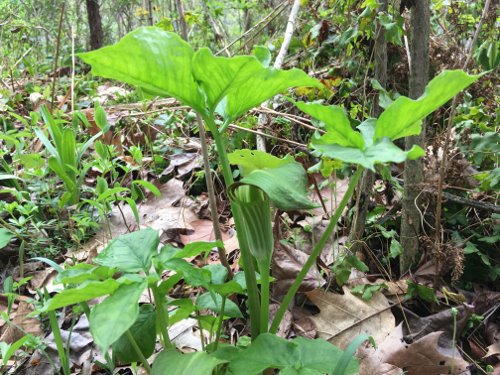
The Jack in the Pulpit that started blooming the day of my birthday on Errf Day I got to enjoy a little longer. Along with the ladyslipper orchids. The Chinese Ground Orchid that I was looking forward unfortunately did not have a good bloom this year. It looked promising after the tips of the sprouts coming out of the ground got nipped in an earlier frost in April—but the buds may have been damaged and they remained small and fell off before opening. At least there is plenty of healthy foliage and a chance for better luck next year.
Some other highlights of late spring were more plant orders. First were the cycads I got to spruce up the box turtle pen in the greenhouse a little more. Two Zamia pumilia —the Florida Coontie or Seminole Bread and a large specimen Dioon edule —a neat looking Mexican species that was unfortunately packed in haste in a box way too small and suffered serious frond damage in transit.
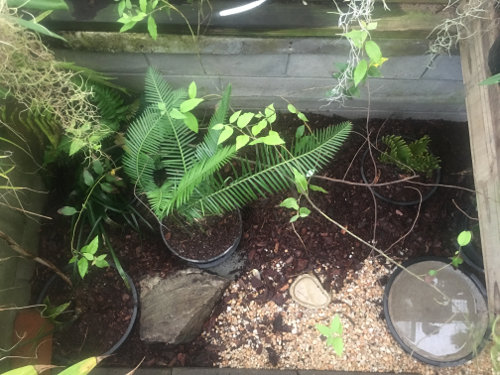
I managed to prop the broken ones up in the scraggly Litsea bush to make a fairly decent looking display and to hopefully keep them alive until the plant grows more to replace them. Cycads are funny things being they are very slow growing —even worse than Palms. I have a couple more from the same source that have not put out a flush of new growth for several years. For the longest time I've wondered how these plants of prehistoric lore kept up with the appetites of plant eating dinosaurs. Could be because of the hard cardboard or plastic like nature of the foliage which tends also to be a bit prickly and might be unpleasant for even Jurassic sauropods to browse upon. There were probably a lot of other softer plants and trees to nourish dinosaurs and contribute to their flatulence!
Cycads are also toxic and nothing alive today that I know of other than humans will eat them. And in that case —only the fleshy trunk like rootstock that is referred to as a caudex by botanists and horticulturalists—which is ground up and processed by a labor intensive process of soaking to leach out the toxins. And the process is pretty much done the same with various species by indigenous peoples the world over from the Seminole Indians in Florida to people in New Guinea and Southeast Asia and probably Australia and Africa as well.
As you can tell; I have a thing for unusual and prehistoric plants. Another favorite are the horsetails which go even farther back—even way before the dinosaurs and were among the first vascular plants to live on land. I've seen fossils of them in the local sandstone and someday I'm going to find a nice one in a big slab that I incorporate into my rock garden along with maybe some prehistoric club mosses—which are known as 'scale trees'. Perhaps at the local quarry. As for living representatives I have three species of horsetails—the native Equisetum hyemale which is the Rough Horsetail or Scouring Rush that grows about knee to waist high and that one lives in a sandy pocket by the Rosyside Pool of my watercourse. And the dark grassy stuff on the shoreline of the upper pool seen in previous editions is a dwarf species —scirpiodes that is more northern in its native range—I've seen it abundant in the swamps of Michigan. But it grows well even here and is well known in the water garden trade. Mine came from a nursery in Virginia many years ago.
Also have a couple planters of the Water Horsetail in the big pond that I collected by digging out a few pieces out of the sand under about three feet of water in the Great Marsh of Wisconsin circa the year 2000. That was an interesting experience.
I don't count the common Field Horsetail that appeared as a weed by my greenhouse—and I'm trying to get rid of it almost in vain because it's one of those plants that is difficult to transplant and usually won't grow where you want it to—but will come in on its own by a spore borne on the wind or a piece of rootstock in the sand that I used to make my sand beds and it can be a loosing battle trying to stop it from taking over! Quite a few species of horsetails are like that. Like many an invasive weed they can be as impossible to get rid of as herpes and these are in most cases native species!
But I digress again.
One more digression —I want to make mention of a couple more new plant arrivals—a variant of a native wild ginger —Asarum species from Plant Delights that I had to get because the flowers are said to look like the bloodshot eyes of Lindsey Lohan coming back from a three day drunk ! I've always appreciated the humor often manifest in their cover art and catalog descriptions ripping on many celebrities and politicians who deserve every bit of it. From comparing the Amorphophalus konjak to Bill Clinton to comments about the "Berkeley Sedge" formerly promoted as a California native and later outed as an alien of Eurasian origin —which it was speculated—made the Eco Nazis as unhappy as Mel Gibson locked in a synagogue! That one had me rolling.
I planted the Lindsey Lohan ginger on the bank below the Chinese Box turtle pen opposite the stepping stones from the Carolina Silver ginger from the same source planted at least a decade ago. Will probably have to wait until next spring to see the bloodshot eyes but a couple of the rain lilies that came with it will probably bloom by the time the next edition or the one after it comes out later this summer.
There is also the Podocarpus tree that arrived late this week to join my growing bonsai collection. I could get into that but it has great potential for another future article on cultural appropriation that I'm thinking about and I've probably already bored the non —horticulturists to death already!
But that's me living in my own little world while the outside world beyond my property line continues on the fast track of the Highway to Hell. Which makes for the opportunity to make my mission statement again ; which is the purpose of the Norseman's Diaries. To enlighten and enchant and offer the reader at least a brief vicarious escape from the insanity and tyranny that surrounds us. And maybe as a blueprint for others to create their own oasis of paradise and personal happiness in an increasingly unfree and unhappy world.
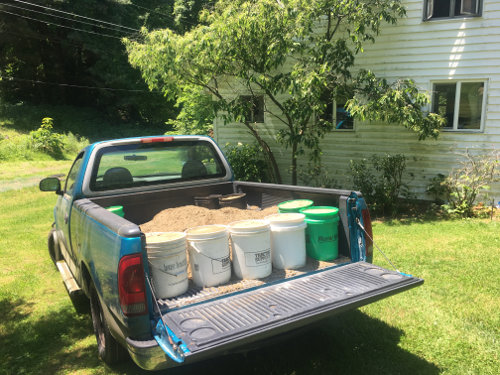
Which I was laboring at in the heat most of the day and the reason I am once again pushing the envelope late Saturday going on midnight in hope of maybe getting it into the upcoming Sunday edition. The project this time was finishing up the first row of beds in my square foot garden that involved trucking in a load of topsoil and sand to fill the raised beds —to which I also added my own compost and some bagged pine bark fines and peat I was lucky to have on hand. Getting it done a bit late in the season but still in time for tomatoes and other warm season vegetables.
This is the latest incarnation of a struggle that has been ongoing for years since I discovered the roots of nearby walnut trees were invading my original in-ground beds and causing the tomatoes and some other plants to wilt. It's called allelopathy and it will be explained in a future installment—or you can look it up in the meantime.
I am also in the process of brainstorming with my friend Ray who needs to find a way to make his property less bird friendly to a Great Blue Heron that has decided to use his backyard ponds as an all you can eat buffet!
Stay tuned for future editions.
End Notes: at least there was some good news this week trickling from the nasty outside world into my own—Mr Trump blew off the perpetrators of the climate change racket by pulling the U.S. out of the non-binding agreement made by his predecessor. Won't go into the details because most readers probably know all about it and it won't surprise me if another contributor writes an article about it.
At least maybe a reprieve from those who want to limit our options and make us freeze to death in the winter because of artificially induced fuel poverty.
As if my own predicament is not tight enough already. There was disturbing news earlier this spring that my firewood supplier may be selling his business and looking to retire. But they said they can still get me a few loads this summer and there is the possibility they may decide to keep their wood processor and continue selling firewood. Bruce the Historian also assured me that is likely to be the case. Yet it may be a good idea to start shopping around as this situation is the classic case of the perils of becoming dependent on a single supplier of anything.
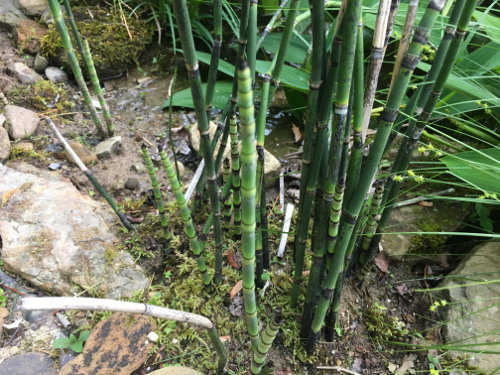
The Rough Horsetail—equisetum hyemale
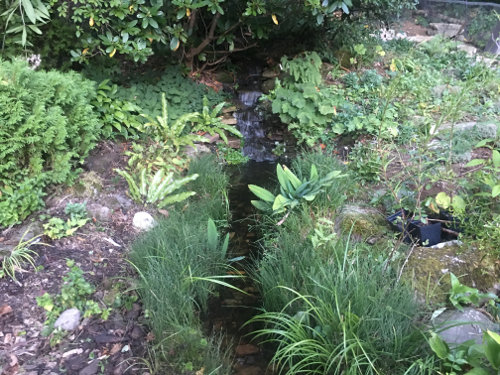
Dwarf Horsetail—E. scirpiodes
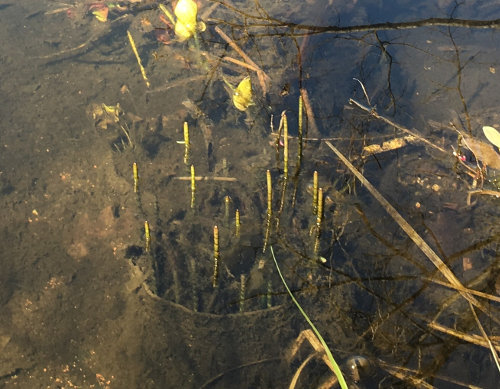
Water Horsetails—Equisetum flutiviale (emerging spears in early
spring)
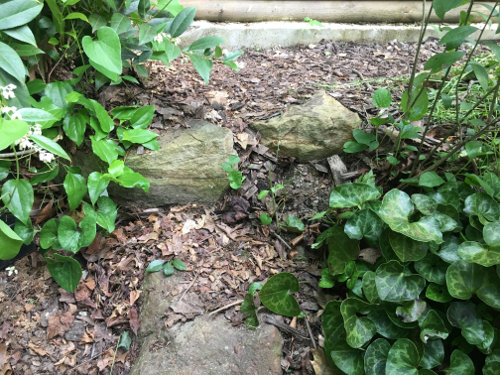
Gingers—Carolina Silver on right side of stone.
new one with Lindsey Lohan's Bloodshot eyes to the left—big surprise!
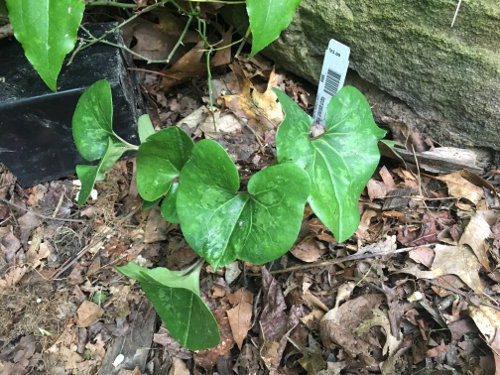
The pricy new ginger—actually a selection of the rare Asarum
speciosum from Alabama. Will probably get listed by the federal
government as "In-Dayn-Jured" someday and be prohibited from
interstate commerce. Good thing I got it when I did!
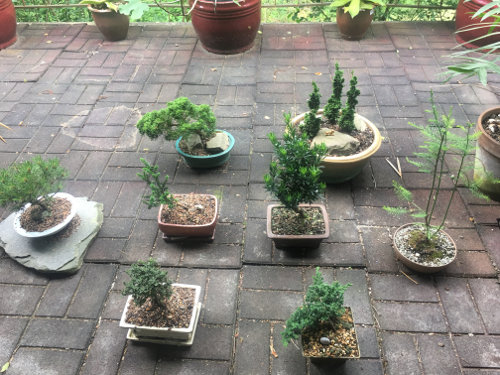
The growing bonsai collection

Podocarpus tree. Aka the Buddhist or Yew Pine. A really nice specimen
that came in an equally nice bonsai pot that arrived Thursday. Used
to be popular in the retail house plant trade a while back and grown
as an outside plant in the Deep South and California.

Raised beds almost garden ready.
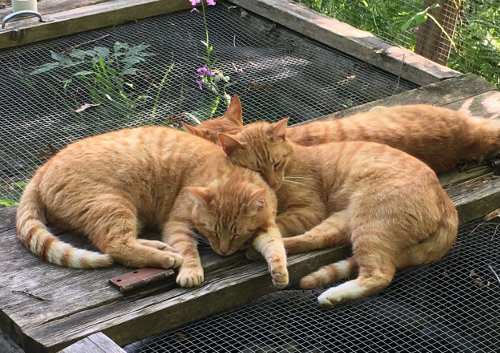
The tired little tigers; Fat Tom; Slim Jim and Boots.
Was that worth reading?
Then why not:
![]()
This site may receive compensation if a product is purchased
through one of our partner or affiliate referral links. You
already know that, of course, but this is part of the FTC Disclosure
Policy found here. (Warning: this is a 2,359,896-byte 53-page PDF file!)
TLE AFFILIATE
![]()

